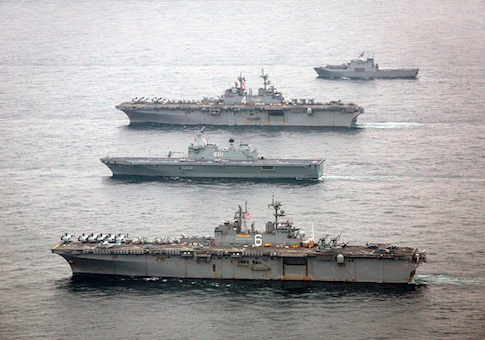The U.S. Navy doesn't have enough amphibious warships to effectively support the Marine Corps in training for combat operations, according to senior Pentagon officials.
Marine Lt. Gen. Brian Beaudreault, deputy commandant for plans, policies, and operations, said Friday the current fleet of 32 amphibious assault ships falls short of the number needed to meet operational requirements. He said this negatively impacts the ability of joint naval forces to train, particularly in large-scale formations, which harms readiness.
Beaudreault, testifying before the House Armed Services Subcommittee on Readiness, said the training shortcomings have left at risk the "core competency" of the Marine Corps and Navy to move a combat force from ship-to-shore to rapidly penetrate enemy battle space.
"We can do some training…through virtual systems, but at some point you have to put the ships to sea and go through a mission rehearsal," he testified. "The ability to generate the number of ships required to train at a Marine expeditionary brigade level just simply isn't there, so we take it in bite-size chunks."
The Navy has said it needs as many as 38 amphibious ships to meet rising operational demands, but the service likely won't be able to reach that number until 2030 due to budget constraints.
A report released Friday by the Government Accountability Office identified the lack of available amphibious ships on which to train sailors as the most prevalent factor impeding training completion.
In 2016, for example, data collected from the 1st Marine Expeditionary Force, which operates in the Pacific, revealed the Navy was unable to fulfill more than 90 percent of requests for support training due to a lack of ships.
"These deficits can create a potential gap between the Marine Corps' 'ready bench' of units and, if called on, these units could be left scrambling to obtain last-minute training, risking their ability to be fully ready once deployed and underway," testified Cary Russell, director of the defense capabilities and management team at GAO.
Both Beaudreault and Navy Vice Adm. Andrew Lewis, deputy chief of naval operations for operations, plans, and strategy, who also testified Friday, agreed with the study's findings. They both stressed the need for stable, predictable, and adequate funding over several years to confront readiness challenges.
"The most important actions that Congress can take now is to immediately repeal the caps on defense spending under the Budget Control Act and provide a defense appropriation that provides a sufficient, consistent, predictable funding," Beaudreault testified.
